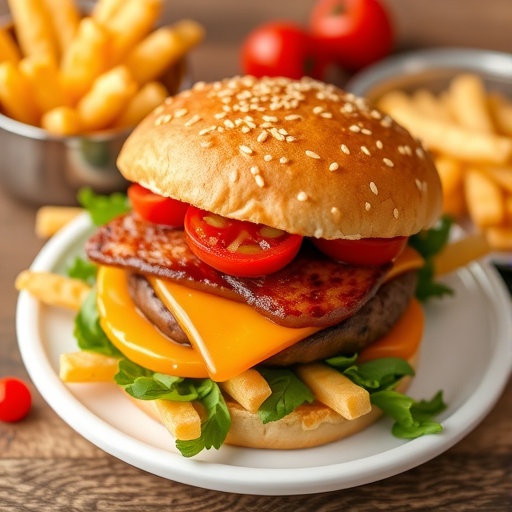A recent observational study published in BMJ Nutrition Prevention & Health casts a revealing light on the complexities underpinning consumer choices in the digital era of food ordering. Despite the regulatory implementation of calorie labelling legislation in England, aimed at curbing rising obesity rates and encouraging more informed dietary decisions, it appears that taste and price remain the dominant forces driving takeaway food purchases among adults. This nuanced investigation delves into the interplay of behavioural, demographic, and perceptual factors influencing the frequency and nature of takeaway consumption, challenging the efficacy of calorie labelling as a solitary public health intervention.
The legislative mandate requiring food businesses with more than 250 employees to display calorie information online came into effect in 2022. The initiative intended to empower consumers by enhancing transparency about caloric content, thus fostering healthier eating habits. However, survey data from a representative panel of 1,040 adult takeaway consumers in England reveal a stark disconnect between awareness and actual behavioural response. While approximately two-thirds of respondents acknowledged awareness of the labelling policy, the majority admitted to either overlooking calorie information entirely or being unaffected by it in their ordering decisions.
Demographically, younger adults under the age of 35 were disproportionately frequent users of online takeaway services, ordering at least once per week at rates more than double those of older cohorts. Similarly, individuals classified as living with obesity exhibited a significantly higher propensity for frequent takeaways compared to their healthy weight or underweight counterparts. These findings underscore a critical intersection between socio-biological factors and food consumption patterns, highlighting a target demographic for future public health interventions aiming to reduce the burden of diet-related diseases.
Intriguingly, consumers’ knowledge of recommended caloric intake for a typical meal was largely inaccurate. On average, participants overestimated the advised calorie content by roughly 25%, with a mean estimate of around 747 kilocalories compared to the guideline of 600 kilocalories per meal. Notably, women demonstrated twice the accuracy compared to men in assessing appropriate calorie levels, emphasizing potential gender differences in nutritional literacy or health-consciousness that may influence eating behaviour and response to labelling.
Importantly, the study’s survey uncovered that the consumers’ principal motivations for selecting takeaway foods were sensory and economic rather than nutritional. Taste was unequivocally identified as the foremost factor influencing takeaway choices, closely followed by price sensitivity, delivery speed, and portion size considerations. In contrast, while healthiness did factor into the decision-making for home-cooked meals for a majority of respondents, it ranked much lower in the hierarchy for takeaway purchases. This delineation suggests a psychological and contextual divergence in how people approach meals prepared at home versus those obtained externally.
The efficacy of calorie labelling was further undermined by consumer inattention; 77% of participants did not notice calorie information during their most recent online takeaway transaction. Even among the minority who did notice, 71% reported no change in their food selection, and a comparable percentage noted no impact on associated drink choices. Alarmingly, a small fraction even admitted to selecting higher-calorie items post-exposure to labels, illustrating that information alone may not suffice to counteract ingrained preferences or social influences driving high-calorie food choices.
This study’s results carry significant implications for public health policy. The limited influence of calorie labelling alone suggests that multi-faceted strategies integrating behavioural economics, environmental nudges, and regulatory frameworks are essential to reshape dietary practices at the population level. For instance, respondents expressed tentative support for additional interventions, with nearly half favouring traffic light labelling systems and healthier alternative provisions as means to encourage better nutrition. Conversely, price adjustments targeting less healthy options and exercise-equivalent calorie disclosures garnered lesser but notable endorsement.
Furthermore, the role of demographic variables in health prioritization was evident. Women were over 50% more likely than men to rate healthiness as a very important criterion in takeaway decisions. Similarly, individuals aged 65 and above were four times as likely as younger respondents to emphasize health considerations. These disparities underscore the necessity of tailored messaging and interventions that resonate across diverse segments of the population to maximize reach and impact.
The study, while insightful, acknowledges inherent limitations typical of observational designs. It cannot conclusively infer causality between labelling policies and behaviour change. There was also underrepresentation of men and younger adults, groups known to engage frequently in takeaway consumption, as well as limited respondents who indicated behavioural shifts attributable to labelling. These caveats call for augmented real-world experimental trials and longitudinal assessments to distill causative mechanisms and to identify context-specific opportunities for intervention.
Given the mounting global challenges posed by obesity and diet-related chronic diseases, the findings accentuate that calorie labelling, despite its potential benefits, remains only a partial solution. The complexity of food choice dynamics necessitates integrated approaches that combine regulatory, educational, and environmental strategies. Policymakers and public health professionals should view calorie labelling as one element within a broader arsenal aimed at fostering sustainable, equitable improvements in dietary health without exacerbating existing socio-economic disparities.
In summation, while calorie labelling legislation represents an important step towards transparency and consumer empowerment, its real-world impact on takeaway food choices is limited by low visibility and minimal behavioural influence. The dominance of taste and price as primary drivers in the digital takeaway marketplace highlights the formidable challenge of aligning public health goals with consumer priorities. Future research and policy must seek innovative, context-sensitive solutions that synergistically address the multifactorial determinants of unhealthy eating to effectively combat the obesity epidemic.
Subject of Research: People
Article Title: Calorie labelling and other drivers of takeaway food choices
News Publication Date: 12-Aug-2025
Web References:
http://dx.doi.org/10.1136/bmjnph-2025-001268
References:
Published in BMJ Nutrition Prevention & Health
Keywords: Nutrition, Calorie Labelling, Takeaway Food, Consumer Behaviour, Obesity, Public Health Policy




